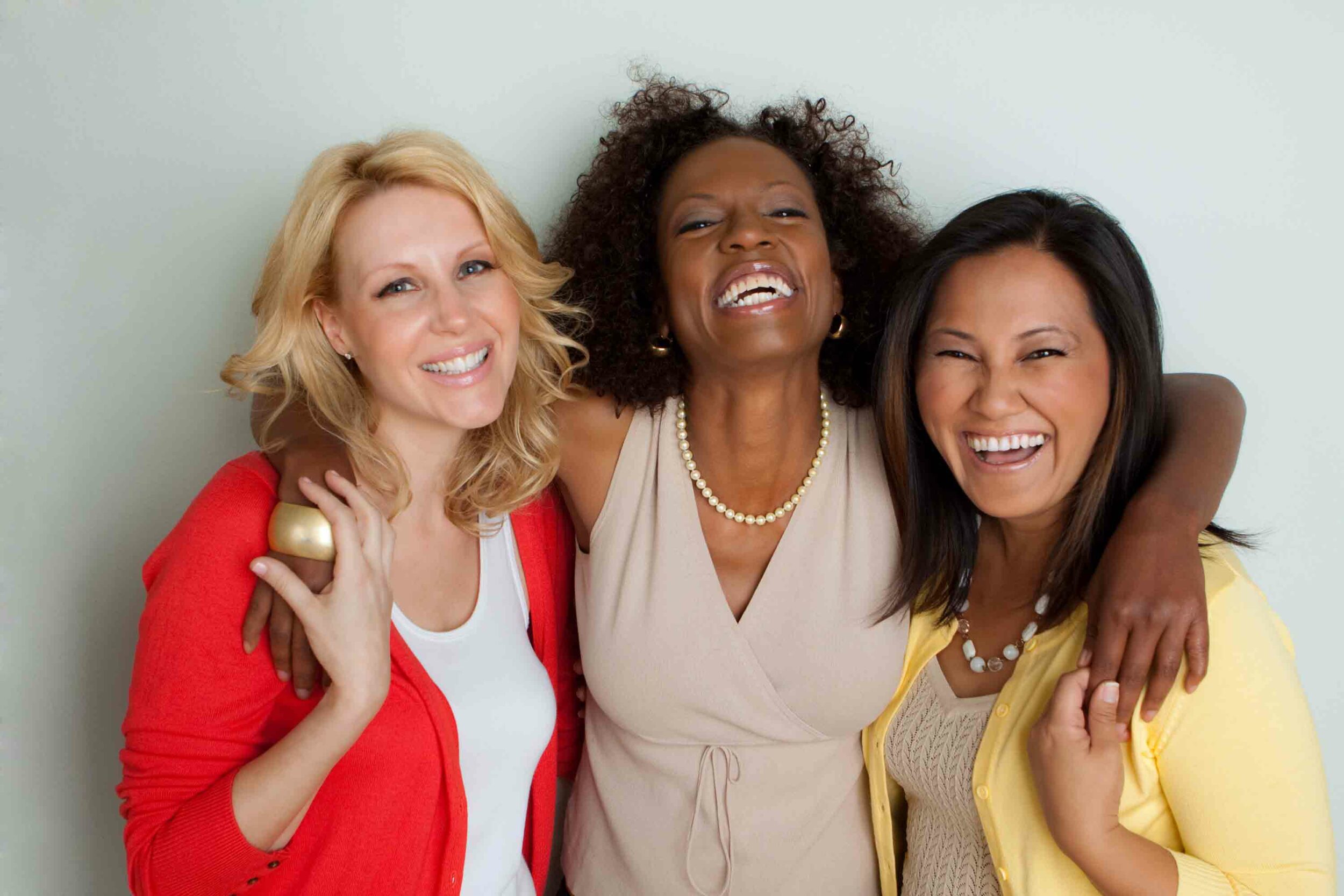5 Ways I Learned to Love My Middle-Aged Body

The other day, as I was participating in my daily scroll on social media, a Facebook memory popped up on my feed. It was a heartwarming throwback of me and my youngest when she was just a baby. I looked tired, yes, but also had that new-mom glow as I held my daughter in her “Baby’s First Christmas” outfit. She was three months old and this was, sadly, quite a few years ago.
I remember that picture well. We were at my in-laws’ house after church, and it was the first time I had gotten “dressed up” since giving birth. And I remember being wildly insecure about my new, mom-of-three body. I felt frumpy, overweight, and gross. I didn’t want to go, and I didn’t want to take that picture.
Fast forward, as the 40 something-year-old me looks at 32-year-old me, all I can think is, “I would give my right arm to be that frumpy right now.” Because 40 something-year-old me actually wishes she had that figure, that skin, that hair—all of the things I felt so insecure about back then.
I Don’t Recognize My Middle-Aged Body
Now, as I am deeply entrenched in my own middle-aged body and feel often like a stranger in this skin, I am envious of the woman in that picture. I’m jealous that even though she felt insecure, the weight still came off easily and things were still in the same relative place they had always been. And her body, though nursing a newborn at the time, was still decidedly more her own than the one I am in now.
The nitty gritty truth is that my middle-aged body feels alien to me. I feel like I blinked, or more accurately, turned 40, and things started to change and shift, and I honestly have no idea what is going on or who the person staring back at me in the mirror is.
Middle-aged body changes are not for the faint of heart.
Nobody Mentioned All the Body Changes
One day I was a size 2. The next, I wasn’t. Nothing changed other than the age on my driver’s license, yet my body did not look, feel, or act the same. I started sweating. Like, a lot. And not in that glistening way you sweat when you’re working out in your 20s. I mean sweat sweat, no workout required. In fact, sweat is most likely to occur when I’m sleeping. My husband now calls me Hot Legs. This is not, by the way, a compliment.
My skin breaks out again in a weird flashback to my teenage years. I have brain fog that rivals my three-time pregnancy brain. And I’m tired and I ache. This woman who once walked New York City blocks in heels and then went dancing afterwards needs a good cup of tea and an Epsom salt bath after a short jaunt around the block.
5 Ways I Am Learning to Accept My Middle-Aged Body and Adjust with the Changes
All of this is to say, I’ve had some trouble adjusting.
But adjust, I have. What other choice is there? Instead of wallowing in self-pity about this new body, I have to learn to live in it at the very least and love it again at the most. And the only way I was going to do that was to research, learn, and figure out what works for a 40 something-year-old woman. Because it’s become increasingly clear that what worked for 20- and 30-year-old Meg is off the table now. I need to up my middle-age game.
And this, dear friends, is how I did it. Now, I’m not a doctor, nor am I an expert. If you have serious issues or just that tugging intuition that something is less than normal in your body, please, by all means, get medical attention. These are just merely some tips and tricks I’ve used to make peace with—and yes, learn to love—this middle-aged body of mine.
1. Move Your Body, But Don’t Beat It Up
When I was in my 20s, if I felt the need to lose a few pounds I would skip pasta, spend hours beating my body up on the treadmill, and switch to diet soda for a few weeks. It always worked, probably because I was in my 20s.
But for more mature bodies, this is not the answer. Not only is it ineffective, it also can be counterproductive. That excessive hardcore cardio that worked when we were young can actually trigger a cortisol response in our older years, eventually leading to excess belly fat. So instead, I swapped out hard cardio for strength training three times a week, which both boosts metabolism and wards off osteoporosis by strengthening bones. On alternate days, I walk or do yoga, both of which have been shown to lower cortisol and honestly, are just more enjoyable than hardcore, make-me-want-to-vomit cardio.
2. Notice the Way Your Body Responds to What You Consume
When I was young, I could eat whatever I wanted, when I wanted, and still expect to maintain a reasonable weight. I didn’t worry about the quality of the food I was eating because, let’s face it, I was poor and ramen is cheap and tasty. But I still felt fine no matter what I ate. When you’re 20, that’s the norm.
 Now, as I’ve gotten older, I’ve learned that this isn’t always the case, and what I put into my body matters greatly. So, I began to listen, taking notice of what is serving me and what isn’t. I realized that certain foods just don’t agree with me and others make me feel good. I’ve made peace with the fact that the diet of my younger years is not going to work as I get older, and that’s okay. I focus more on whole foods and less on convenience.
Now, as I’ve gotten older, I’ve learned that this isn’t always the case, and what I put into my body matters greatly. So, I began to listen, taking notice of what is serving me and what isn’t. I realized that certain foods just don’t agree with me and others make me feel good. I’ve made peace with the fact that the diet of my younger years is not going to work as I get older, and that’s okay. I focus more on whole foods and less on convenience.
I cut down on caffeine because I found that the moment I went over one cup was the moment I started to feel awful. And I cut alcohol out completely because it wrecks my sleep. This is not foolproof, mind you, but listening to your body helps you understand what works and what doesn’t for your specific metabolism (and it does vary from person to person).
3. Notice the Accounts You’re Following and Add or Subtract
If you were to spend any time on my Instagram feed, you would see primarily food pictures with a fair amount of fashion and fitness influencers mixed in for good measure. But I began to notice that most of my fashion and fitness influencers don’t look like me anymore. They’re beautiful and fit and incredibly on-trend, but they don’t look like me. They look, well, younger. And when I examined that further, I realized that while this wasn’t terribly damaging to my self-esteem, it wasn’t incredibly helpful either.
So I began to purposely seek out profiles that felt like mirrors. I found fashion influencers to help me dress (more on that below) in Jaime Diehly Style, MelanieKPersonalStylist and The Glam Gypsy, and I found fitness professionals to help me figure out what works best for my middle-aged body in gurus like carrotsncake.
I didn’t weed out and unfollow everyone younger than me, but I did add in people who reflect where I am today and can provide good valuable content to help me be my best self at 42 and beyond.
4. Learn How to Dress Your Middle-Aged Body and Feel Confident
I will be the first person to admit that some of the changes I’ve gone through in middle age have actually been for my benefit. The pounds I have put on were, for the most part, needed as I have been underweight for most of my adult life. I just didn’t feel comfortable with them, and more importantly, I had no idea how to dress myself once they appeared.
The same rules didn’t apply any longer, and the things I had been wearing for decades did not work for me. So instead of fighting against nature and trying to reshape my body back into an ideal it was never going to reach again, I decided to work with what I have.
For me, that meant hitting up a personal shopper for a fitting session. I had her take my measurements, explain to me about body shape and help me figure out what classic pieces I could wear that would flatter, rather than detract from, my newfound curves. And you know what? Once I did this, I began to see the benefits of my new shape and began to love the skin I was in.
This doesn’t require a trip to the personal shopper, though. If cost prohibits you from taking this plunge, check out Pinterest and the amazing Instagram profiles I listed above or my Instagram for style advice and sizing guides. There are incredible resources out there to help you figure out your shape and how to dress it.
Instead of fighting against nature and trying to reshape my body back into an ideal it was never going to reach again, I decided to work with what I have.
5. Appreciate What You’ve Got and Consider, “What Defines Me?”
At the risk of sounding trite, all of these physical swaps and switches are never going to work if we don’t get our story straight about who we are and what we’re worth. There is absolutely nothing wrong with working to change things we don’t love about our appearance and our bodies. There is nothing wrong with striving to look better and be better versions of ourselves. There is something wrong, though, when we start to focus so heavily on the ideal and the change that we forget that we are loved exactly as we are and to appreciate the life that got us here.
See, we are valued beyond measure whether we have new wrinkles (which I do) and more grey hair (also yes) or we don’t. In fact, in the grand scheme of things, those wrinkles are physical representations of the lifetime of smiles and laughs I’ve had with the people I love. The grey hair, well, as much as I hate it, it’s probably from the act of motherhood and these three kids I’ve been charged with raising into responsible, kind adults. And that’s okay, too.
Recognizing that I’m worthy of love no matter what the scale says or how much I sweat at weird times is a key component to the mental game of aging. Because once I am fully grounded in my worth and my value, I am free to continue my journey towards becoming my best middle-aged self not because I need to feel valued but because I want to. And trust me, dear friends, there is a huge difference.
For more tips for the middle age life follow Meaghan on Instagram.
—
Don’t forget to love yourself for who you are, too. Check out this podcast episode from This Grit and Grace Life: What Makes a Woman Beautiful (Might Surprise You) – 043


